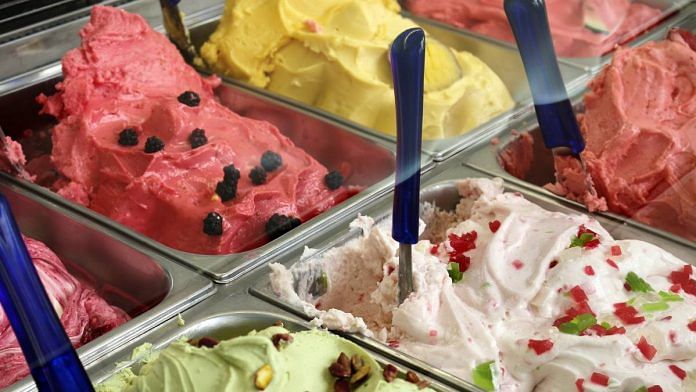New Delhi: Ice cream lovers may soon have to shell out more as prices of milk and milk products are expected to rise further over the next few weeks.
Speaking to ThePrint, government officials said prices of ice cream and frozen dessert could see an increase by at least 7-10 per cent in the next few months, owing to shortfall in milk procurement from cooperatives and federations.
On 3 January, Avinash Kumar Srivastava, secretary, Department of Animal Husbandry & Dairying, took stock of the availability and pricing of milk and related products in the country in a meeting with industry stakeholders.
During the meet, ice cream manufacturers informed the ministry that continued inflation in milk and related products could lead to an increase in prices of items in their portfolio.
If the shortfall in procurement continues, there could be a Rs 8-10 increase in liquid milk prices while prices of skimmed milk powder (SMP), a crucial ingredient in making ice cream, may go beyond Rs 400 per kg, the ministry was apprised.
Also read: Tackling onion price rise leads to policy distortions, but it seems nothing will change
‘Due to rains’
In December, major milk cooperatives like Amul and Mother Dairy increased milk prices by Rs 2-3 per litre, citing an extended monsoon and delayed onset of the flush season — the period between December and March when milk supply is at its peak.
“Prices of SMP increased to Rs 330-350 per kg in December 2019 from Rs 230-250 per kg last year. Several ice cream makers cited the increase in SMP prices in the meeting,” a senior dairy ministry official told ThePrint.
The average rate of SMP has hovered around Rs 150-250 per kg in the last four-five years. However, since the summer of 2019, rates have gradually increased from Rs 180 per kg to Rs 330 per kg now, added the official who didn’t wish to be named.
A Mother Dairy spokesperson told ThePrint that there has been a significant rise in the input costs both at the farmer and, subsequently, at the manufacturer level.
“Due to the effect of rains, the cost of feed ingredients like de-oiled rice bran, rice bran etc. have gone up, resulting in higher feed costs by around 25-30 per cent. It is pertinent to note that feed & fodder constitute almost 70 per cent of total cost of milk production,” said the spokesperson.
The scarcity of milk has been reported from all parts of the country. It is estimated that India is currently reeling under a milk deficit of nearly 10-15 per cent as compared to last year.
Owing to increase in input costs, the consumer prices of milk and milk products have seen an impact, said the Mother Dairy spokesperson.
“For example, in ice cream, we have partially passed on the cost (around 3-5 per cent) to the consumers, that too in some variants of the Take Home range. As we progress ahead, we are keeping a close watch on the situation,” added the spokesperson.
Also read: Verghese Kurien, the engineer who ‘dairied’ to dream and ushered in the White Revolution
Create buffer stock for SMP
At the meeting, the Indian Ice-Cream Manufacturers Association (IICMA) pushed for import of SMP in next seven to 10 days to make up buffer stock. This will check inflation in prices, said the group.
“We have raised a demand to the government for the (buffer stock) creation of at least 65,000 tonnes of SMP for the peak period of April-July as our year-long consumption is around 1 lakh tonnes,” said Anuvrat Pabrai, regulatory committee member, IICMA.
Pabrai said the buffer stock would be a win-win for both consumers and farmers. “During the glut period it could be established by domestic procurement providing remunerative prices for farmers whereas in shortage it can comfort the consumer.”
Speaking about the shortage, he said in Maharashtra alone there has been a 25 per cent decrease in milk procurement.
“Amul, which used to have 1.5 lakh tonnes of SMP till last year has only 50,000 tonnes this year. Similarly the SMP holding of Karnataka milk federation has also gone down from 22,000 tonnes last year to 3,000 tonnes now.”
According to a senior official in the Ministry of Animal Husbandry, Dairying and Fisheries, if the situation doesn’t improve in the next three months, the government might be compelled to make a recommendation to the commerce ministry to cut down incentives offered under the Merchandise Exports from India Scheme (MEIS) before going ahead with imports.
MEIS was launched in 2016 to promote export of notified goods manufactured in India. The incentive, which was initially up to 10 per cent, was later revised to 20 per cent.
In the last financial year, India had seen significant growth in the exports of milk and milk products.
Also read: Modi govt backs cow dung-based farming. Now its own officials call it a ‘myth’




Is this really a front page item for a national newspaper?? Sheesh